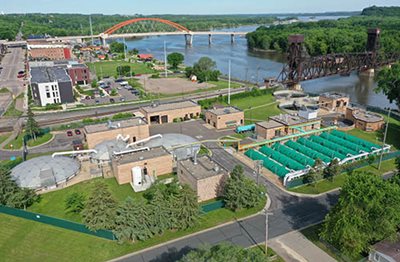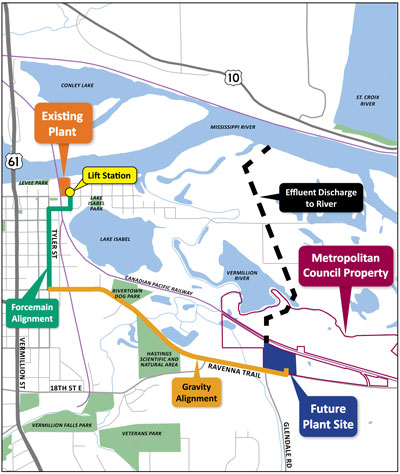 Metropolitan Council Environmental Services is moving ahead with plans to relocate the Hastings Wastewater Treatment Plant. The facility needs to be replaced because significant plant upgrades — required to handle future growth and potential regulatory changes — are not feasible at the present site.
Metropolitan Council Environmental Services is moving ahead with plans to relocate the Hastings Wastewater Treatment Plant. The facility needs to be replaced because significant plant upgrades — required to handle future growth and potential regulatory changes — are not feasible at the present site.
“Relocation of the plant at this time avoids major investments at a site that cannot meet the long-term needs of the plant’s service area,” said Heidi Hutter, Environmental Services engineer.
The Met Council has set a public hearing for January 5, 2022, to gather input on the draft facility plan for the new plant.
Hastings plant has a stellar environmental record
The Hastings plant opened in 1955 and has the capacity to treat 2.34 million gallons of wastewater daily. For the last 30 years, Environmental Services has operated the plant in perfect compliance with its federal clean water discharge permits — one of the best records in the nation.
The Met Council’s 2040 Water Resources Policy Plan calls for a new treatment plant in Hastings to support the long-term sewered development of the southeast metro. Environmental Services acquired land for the new plant in 2005.
The 221-acre site will allow for future plant expansion, with a long-term service area that includes portions of Marshan, Nininger, and Vermillion townships. Like the current plant, it will discharge to the Mississippi River. The new plant will have the capacity to treat 10 million gallons per day.
“The City of Hastings has been very successful in the revitalization and redevelopment of the historic downtown waterfront,” said Met Council Member Wendy Wulff, who represents the area on the Met Council. “This has, however, created challenges for the existing wastewater plant, as there is not room for expansion in the current location. We knew that we would eventually have to relocate the plant, and have planned for that for some time. With growth resuming in Hastings, now is the time to begin the transition to a new plant, away from developed areas."

New Hastings plant projected to open in 2027
The new plant will use a conventional biological phosphorus removal treatment process and ultraviolet light disinfection. Solids will continue to be trucked to the Metro Plant for incineration.
In addition, nonpotable use of treated effluent will be maximized at the site to minimize use of city water and groundwater, Hutter said. The site will be landscaped with drought-tolerant species and incorporate state-of-the-art stormwater management.
The draft facility plan calls for a design-build approach, under which a contractor will be responsible for designing and building the plant and certifying its performance before turning it over to the Met Council. Construction is anticipated between 2024 and 2026, with at least a year of commissioning and process proving starting in 2027.
Project cost estimate: $145 million
Total cost of new construction and decommissioning the current plant is estimated at $145 million. Costs include:
- $21 million for a lift station on the existing site ($3M) and conveyance of wastewater to the new site ($18M).
- $121 million for the new wastewater treatment plant ($102M) and outfall to the Mississippi River ($19M).
- $3 million to decommission the existing plant.
All figures include a 30% contingency for undeveloped design details and a 3% annual inflation rate from now until the midpoint of construction (2025) — standard for this type of construction project, Hutter said.
User fees cover the entire cost of wastewater operations as well as the cost to maintain, upgrade, and replace the physical infrastructure of the wastewater collection and treatment system.
Hastings Wastewater Treatment Plant Facility Plan
Metropolitan Council Environmental Services Capital Program